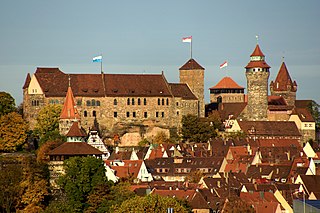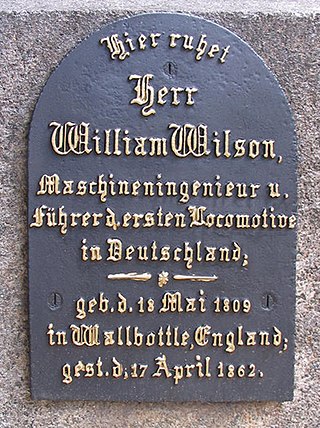
Nuremberg is the largest city in Franconia, the second-largest city in the German state of Bavaria, and its 545,000 inhabitants make it the 14th-largest city in Germany.

Fürth is a city in northern Bavaria, Germany, in the administrative division (Regierungsbezirk) of Middle Franconia.
The history of rail transport in Germany can be traced back to the 16th century. The earliest form of railways, wagonways, were developed in Germany in the 16th century. Modern German rail history officially began with the opening of the steam-powered Bavarian Ludwig Railway between Nuremberg and Fürth on 7 December 1835. This had been preceded by the opening of the horse-drawn Prince William Railway on 20 September 1831. The first long-distance railway was the Leipzig-Dresden railway, completed on 7 April 1839.

The Nuremberg S-Bahn is an S-Bahn network covering the region of Nuremberg, Fürth and Erlangen which started operations in 1987 and is now integrated into the Greater Nuremberg Transport Association. The full length of the five current lines is about 277.6 kilometres.

The Nuremberg–Ingolstadt high-speed railway is a 78-kilometre-long (48 mi) high-speed railway running between the cities of Nuremberg and Ingolstadt in Bavaria, Germany. It branches off the Nuremberg–Regensburg railway and runs parallel to the A9 Autobahn to Ingolstadt, where it joins the Munich–Treuchtlingen railway at Ingolstadt Nord station.

The Bavarian Ludwig Railway was the first steam-hauled railway opened in Germany. The Königlich privilegierte Ludwigs-Eisenbahn-Gesellschaft received a concession to build a railway from Nuremberg to Fürth (6 km) in the state of Bavaria on 19 February 1834.
The Royal Bavarian Eastern Railway Company or Bavarian Ostbahn was founded in 1856. Within just two decades it built an extensive railway network in the eastern Bavarian provinces of Upper Palatinate (Oberpfalz) and Lower Bavaria (Niederbayern) that had previously been largely undisturbed by the railway. Much of this network is still important for local and long distance rail traffic operated by the Deutsche Bahn today.

The Adler was the first locomotive that was successfully used commercially for the rail transport of passengers and goods in Germany. The railway vehicle was designed and built in 1835 by the British railway pioneers George and Robert Stephenson in the English city of Newcastle. It was delivered to the Bavarian Ludwig Railway for service between Nuremberg and Fürth. It ran officially for the first time there on 7 December 1835. The Adler was a steam locomotive of the Patentee type with a wheel arrangement of 2-2-2 or 1A1. The Adler was equipped with a tender of type 2 T 2. It had a sister locomotive, the Pfeil.

Georg Krauß, from 1905 Ritter von Krauß was a German industrialist and the founder of the Krauss Locomotive Works in Munich, Germany and Linz, Upper Austria. The spelling of the company name was later changed from Krauß to Krauss, once the form of the name in capital letters on the company's emblems had become established.

The Nuremberg Transport Museum in Nuremberg, Germany, consists of Deutsche Bahn's DB Museum and the Museum of Communications. It also has two satellite museums at Koblenz-Lützel and Halle. The Nuremberg Transport Museum is one of the oldest technical history museums in Europe and is a milestone on the European Route of Industrial Heritage (ERIH).
The Munich–Augsburg Railway Company, the second private railway company in Bavaria, built the Munich–Augsburg line between 1838 and 1840. It was nationalised in 1846 and became part of the Royal Bavarian State Railways, subsequently forming part of the Bavarian Maximilian’s Railway built between 1851 and 1854.

The Nuremberg-Bamberg line is a German railway connecting the Bavarian city of Nuremberg with Bamberg via Fürth, Erlangen, Forchheim. It is part of the northern section of the Ludwig South-North Railway. It runs along the Regnitz Valley and is one of the important German transport routes. Since 2010 line S1 of the Nuremberg S-Bahn uses the entirety of the line from Nuremberg to Bamberg.

The Nuremberg–Würzburg Railway is a German trunk line railway in northern Bavaria, connecting the city of Nuremberg with Würzburg, the two largest cities in Franconia, and passing through Fürth, Neustadt an der Aisch and Kitzingen. In addition to hourly Regional-Express trains and numerous freight trains, it is served by Intercity-Express trains during the day at half-hourly intervals with some gaps.
The Treuchtlingen–Nuremberg railway is a 62 km long main line in the German state of Bavaria. Most of it follows two parts the historic Ludwig South-North Railway, one of the oldest lines in Germany. Today, even after the opening of the Nuremberg–Ingolstadt high-speed railway, it is still used for long-distance services. It is also used as a detour during closures of the high speed line for maintenance. Between Nuremberg and Roth S-Bahn services run on the parallel Nuremberg–Roth line.
The Nuremberg–Schwandorf railway is a 93.7 km long railway from Nuremberg, running along the Pegnitz river, to Hersbruck and continuing via Neukirchen bei Sulzbach-Rosenberg and Amberg to Schwandorf in the German state of Bavaria. It runs parallel to the Nuremberg–Cheb line between Nuremberg and Pommelsbrunn and this section is known as the Left Pegnitz line. It was opened in 1859 and is one of the oldest railways in Germany.

The Nuremberg tramway network is a network of tramways forming part of the public transport system in Nuremberg, a city in the federal state of Bavaria, Germany. The system reached the neighboring city of Fürth from its opening year to almost a century later when construction of the U1 subway line led to the withdrawal of tram service to and within Fürth. During that era and referring to it historically in literature or nostalgic activities, the system was known as “Nürnberg-Fürther Straßenbahn“. For example, a local association dedicated to preserving the history and heritage of the tram network as well as old rolling stock calls itself “Freunde der Nürnberg-Fürther Straßenbahn“ The system is planned to cross the municipal boundaries of Nuremberg once more, if and when the extension to Erlangen and from there to Herzogenaurach dubbed "Stadtumlandbahn" opens.

William Wilson was an English mechanical engineer and first engine driver on the first German railway.

The Feucht–Altdorf railway is a single-track main-line railway running through Middle Franconia in the German state of Bavaria. It is the extension of the Nuremberg–Feucht railway, which ends at Feucht station, and runs from there to the east through the Lorenzer Reichswald to Altdorf.
The following is a timeline of the history of the city of Nuremberg, Germany.
Nürnberger Versicherung is a German insurance company headquartered in Nuremberg. The group operates in the life, private health, property/casualty and auto insurance segments as well as in the financial services sector, primarily in Germany and Austria.













